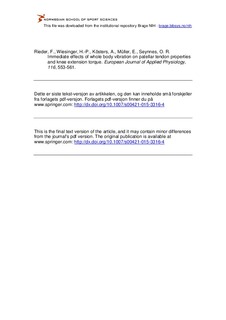| dc.contributor.author | Rieder, Florian | |
| dc.contributor.author | Wiesinger, Hans-Peter | |
| dc.contributor.author | Kösters, Alexander | |
| dc.contributor.author | Müller, Erich | |
| dc.contributor.author | Seynnes, Olivier R. | |
| dc.date.accessioned | 2017-01-24T15:10:02Z | |
| dc.date.available | 2017-01-24T15:10:02Z | |
| dc.date.issued | 2016-03 | |
| dc.identifier.citation | European Journal of Applied Physiology. 2016, 116, 553-561 | nb_NO |
| dc.identifier.uri | http://hdl.handle.net/11250/2428193 | |
| dc.description | I Brage finner du siste tekst-versjon av artikkelen, og den kan inneholde ubetydelige forskjeller fra forlagets pdf-versjon. Forlagets pdf-versjon finner du på link.springer.com / In Brage you'll find the final text version of the article, and it may contain insignificant differences from the journal's pdf version. The definitive version is available at link.springer.com | nb_NO |
| dc.description.abstract | Purpose: Reports about the immediate effects of whole body vibration (WBV) exposure upon torque production capacity are inconsistent. However, the changes in the torque–angle relationship observed by some authors after WBV may hinder the measurement of torque changes at a given angle. Acute changes in tendon mechanical properties do occur after certain types of exercise but this hypothesis has never been tested after a bout of WBV. The purpose of the present study was to investigate whether tendon compliance is altered immediately after WBV, effectively shifting the optimal angle of peak torque towards longer muscle length. Methods: Twenty-eight subjects were randomly assigned to either a WBV (n = 14) or a squatting control group (n = 14). Patellar tendon CSA, stiffness and Young’s modulus and knee extension torque–angle relationship were measured using ultrasonography and dynamometry 1 day before and directly after the intervention. Tendon CSA was additionally measured 24 h after the intervention to check for possible delayed onset of swelling. Results: The vibration intervention had no effects on patellar tendon CSA, stiffness and Young’s modulus or the torque–angle relationship. Peak torque was produced at ~70° knee angle in both groups at pre- and post-test. Additionally, the knee extension torque globally remained unaffected with the exception of a small (−6 %) reduction in isometric torque at a joint angle of 60°. Conclusion: The present results indicate that a single bout of vibration exposure does not substantially alter patellar tendon properties or the torque–angle relationship of knee extensors. | nb_NO |
| dc.language.iso | eng | nb_NO |
| dc.publisher | Springer | nb_NO |
| dc.subject | mechanical properties | nb_NO |
| dc.subject | material properties | nb_NO |
| dc.subject | strength | nb_NO |
| dc.subject | length–tension relationship | nb_NO |
| dc.title | Immediate effects of whole body vibration on patellar tendon properties and knee extension torque | nb_NO |
| dc.type | Journal article | nb_NO |
| dc.type | Peer reviewed | nb_NO |
| dc.subject.nsi | VDP::Matematikk og Naturvitenskap: 400::Basale biofag: 470 | nb_NO |
| dc.source.journal | European Journal of Applied Physiology | nb_NO |
| dc.identifier.doi | 10.1007/s00421-015-3316-4 | |
| dc.description.localcode | Seksjon for fysisk prestasjonsevne /Department of Physical Performance | nb_NO |
